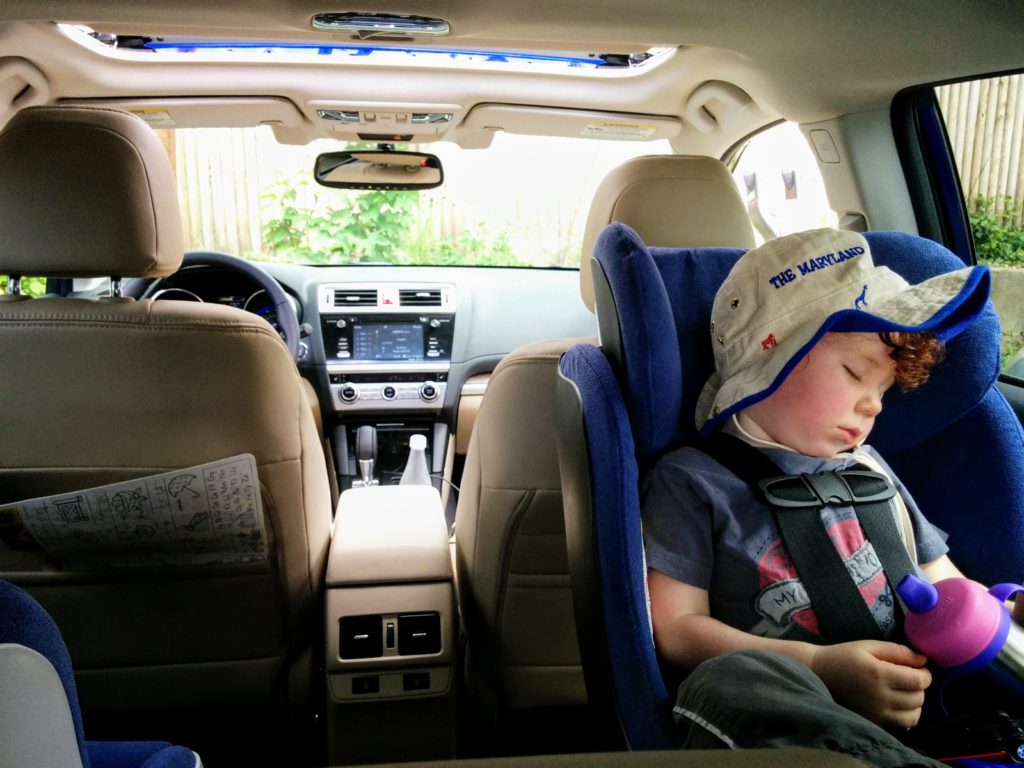
Watch our video! The video below shows how to properly buckle your baby in the car seat straps.
Why bother making straps tight?
Properly snug straps will work to keep your baby safe in a crash, but also help babies breathe better in the car seat by preventing the baby from slumping over and by keeping the head better positioned.
See this section below for an in depth discussion of the risks of improperly strapping your baby in the car seat.
Big kids also need to be strapped in tightly. Watch to make sure you’re buckling your toddler or preschooler in correctly.
If your kid hates tight straps, we sympathize. Disliking being strapped down is developmentally appropriate and typical behavior we see all the time, not only in the car seat but also in the stroller and highchair. Snug straps ensure the car seat will work in a crash so this is one instance where you must put your foot down as a caregiver and insist on the straps being tight, despite your child’s protests. Tight straps won’t hurt a child’s body, but might bruise their ego 🙂
How should your baby’s head be positioned in the car seat?
We get this question all the time and created a whole page to clarify: Newborn and infant head position in a car seat
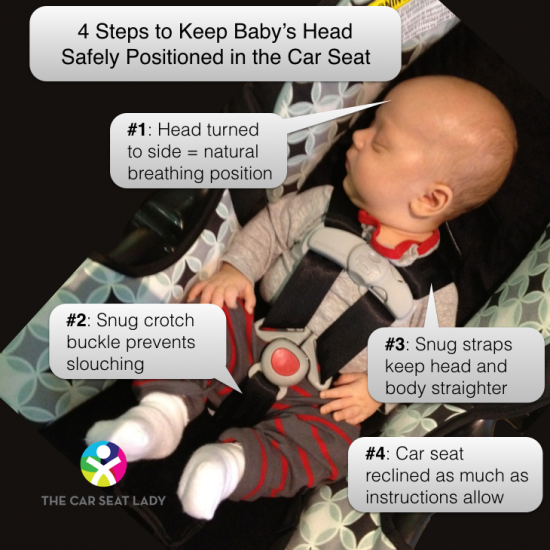
Rear-Facing Children:
Proper Strap Position: The shoulder straps must be emerging from the back of the seat at or just below your child’s shoulders, as seen in this photo.
If you can see the slot where the straps are emerging from the car seat, the straps are too high and must be lowered.
Why do the straps need to be set this way? Properly set straps prevent a child from sliding up the seat in a crash, so they are very important. They also keep a child in the proper position in the car seat when outside the car, so that the child doesn’t slouch or slip into an unsafe position.
Note: A newborn baby may require an infant insert, included with the car seat, to reach the lowest slot. Do not use any inserts that were not sold with your car seat. The infant insert sits underneath the baby’s bottom and raises them up so that their shoulders reach the lowest slot.
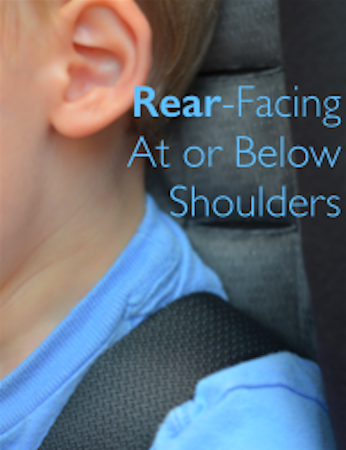
Forward-Facing Children:
Proper Strap Position: The shoulder straps must be emerging from the back of the seat at or just above your child’s shoulders, as seen in this photo.
Why do the straps need to be set this way? Properly set straps prevent a forward-facing child from moving forward too much in the car seat. When straps start from above the child’s shoulders they can better prevent this movement.
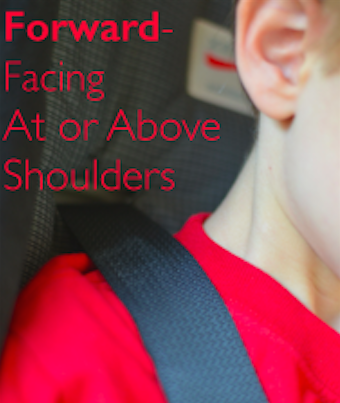
What is an infant insert? This is a removable pad that sits underneath and possibly behind a newborn or small infant. In this photo the green padding is an infant insert, and this 11lb baby has just outgrown the need for it.
Why do you need an infant insert? To safely use a rear-facing car seat, a child’s shoulders must come up at least to the lowest harness slot on the seat. As most newborns aren’t tall enough to reach this slot, RFO car seats often come with a removable infant insert designed to rest under the baby’s bottom, making the baby sit higher in the seat, so that their shoulders reach at or above the lowest strap slot. Some infant inserts are mandatory at certain weights or heights and some are not, so check your car seat’s instruction manual to find out your seat’s requirements.
When can you stop using the infant insert? You may stop using the insert when your child’s shoulders are even with the lowest harness slot setting, or when your seat recommends discontinuing use of the insert. ALWAYS check your car seat’s instruction manual to make sure you are using the insert the right way.
Sometimes the infant insert can make the position of the baby worse, especially if the insert rests behind the baby’s head and pushes it forward, so note if the insert is causing your child an issue like this. Here’s a link to how your newborn’s head should be positioned in the car seat.
Padded head inserts: Infant inserts that just go behind the baby’s head may cause the head to fall into a potentially unsafe position. We recommend these inserts not be used unless specifically required by the manufacturer.
Strap covers: These typically get in the way of a tight fit, so if they are not mandatory (and most are not), we recommend removing them from the car seat.
Note: It is NEVER okay to add another infant insert to the car seat. If it did not come with your car seat, don’t use it!
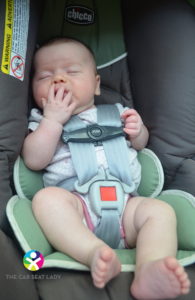
Nearly 10,000 infants a year in the US suffer a head injury when they fall from or in their car seat when its used out of the car. That’s about equal to the number of babies injured in car crashes! Another study found that from 2004-2008, 31 babies died in their car seats due to asphyxiation (lack of oxygen) or strangulation. Most of these injuries occurred outside of the car and often to older babies–the median age was 9 months.
Jaxon’s mom Meredith wants you to know that Jaxon was a bubbly and precocious child, walking at 10 months and running just weeks after. On October 8th 2015, Jaxon ran some errands with his caregiver and fell asleep in his infant car seat. Not wanting to wake him, the caregiver brought him inside to a quiet room so he could finish his nap. The caregiver left the chest clip buckled, but unbuckled Jaxon’s crotch buckle – a mistake many adults make because they feel bad about leaving a baby buckled, especially while sleeping. Jaxon wiggled in his sleep and as he slipped down his throat got caught on the chest clip – and the more he wiggled, the worse it got. When the caregiver went to check on him, it was too late. He had strangled to death. Had the crotch buckle been buckled, he wouldn’t have been able to slouch down, which is what enabled him to strangle on the chest clip.
Shepard was the healthy baby his mom Ali had longed for after 4 miscarriages. On April 6, 2015, Shepard was in the home of his licensed daycare provider. When it was time for his nap, Shepard was swaddled and placed in his car seat. The straps were left completely unbuckled, presumably because he was “just in the house.” While he was sleeping, Shepard wiggled and slouched and his head fell down into a chin-to-chest position. Because he was so young he couldn’t lift his head up to open up his airway. No one noticed in time, and he asphyxiated to death at just 11 weeks of age. Had he been buckled snug he wouldn’t have been able to slouch down, which is what caused his chin to fall to his chest.
Strangulation:
Asphyxiation:
1. Use the car seat as a car seat. Car seats are NOT strollers, cribs, baby swings, a place to nap at daycare, etc. Use the car seat in the car, and then remove the baby from the seat when you arrive. We know it’s a shame to wake a sleeping baby! If you aren’t going to wake your sleeping baby when you get home, make sure to follow the rules below to minimize risk.
2. Put the car seat in the car, on the stroller, or on the floor. Never put the car seat on a soft surface – like a bed, sofa, or even in the baby’s crib. Car seats can overturn when babies wiggle in them and babies have suffocated when their faces press into the soft surface.
Never put the car seat on a shopping cart, counter top, restaurant high chair, table, sofa, etc. Even though it might seem like a good idea in the moment, car seats get knocked off of these high surfaces all the time, leading to the nearly 10,000 head injuries in babies every year in the US.
3. ALWAYS keep the straps completely buckled AND snug. Do not loosen the straps…even if the baby is just finishing his nap on your living room floor, or you’re just in the stroller, or just anything. Snug straps help babies breathe better by preventing the baby from slumping over and by helping keep the head better positioned. Snug straps make it less likely for the baby’s head to fall into a chin-to-chest position. Loose or unbuckled straps are an asphyxiation risk because the baby’s head can fall into an unsafe position for breathing, as happened to Shepard. Loose or unbuckled straps are also a strangulation risk as the baby can roll over and get his neck caught in the straps.
Do NOT buckle JUST the chest clip – this is a significant risk for strangulation. The crotch buckle is there to prevent your child from slouching down in the seat. Without the crotch buckle, babies have strangled on the chest clip; babies like 9-month-old John Norris, 14-month-old Jaxon Lemerand, 17-month-old Major Maxie, and too many others.
